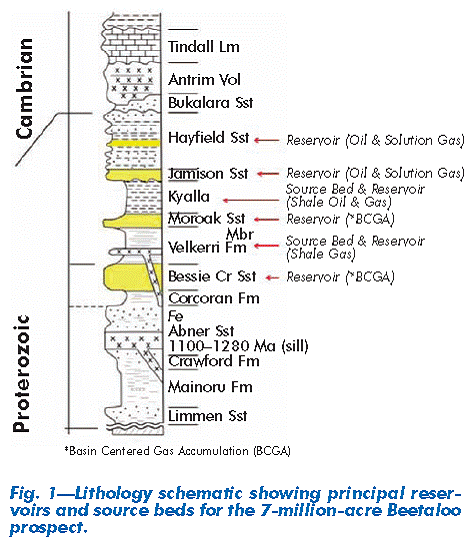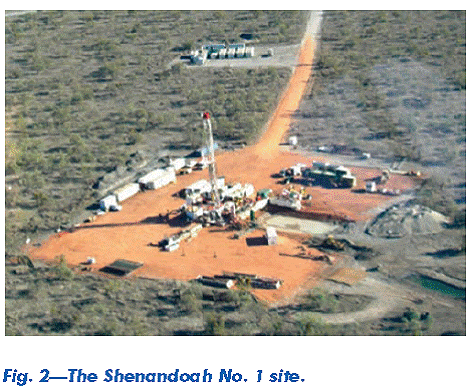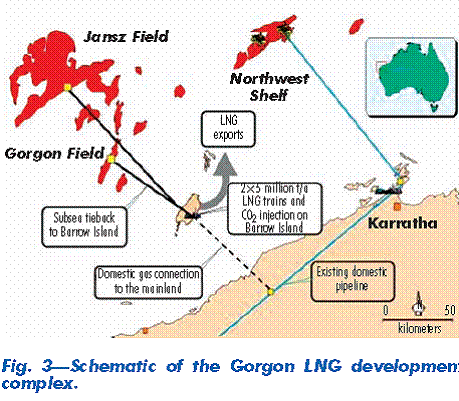Australia
posted on
Mar 08, 2010 09:04AM

Developing large acreage positions of unconventional and conventional oil and gas resources

Browsing in The Journal of Petroleum Technology this weekend, found this interesting article about Australia. Beetaloo and Falcon Oil & Gas is the main topic.
.
Australia Outback Could Be Next World-Class Unconventional Play Jim Redden, Contributing Editor A small Colorado independent believes the 7 million acres it has under license in the heart of the Australian Outback could very well be the world’s next gargantuan unconventional oil and gas play. “This is a huge resource,” consultant Chris Moyes said of the Falcon Oil & Gas holdings in the vast Beetaloo Basin of the Northern Territory. “It is the biggest unconventional resource we know outside of North America. It certainly is of the same class as Gorgon and potentially bigger.” That, indeed, is saying something considering the Chevron Gorgon liquefied-natural-gas (LNG) project at Barrow Island on the Northwest Shelf is widely touted as one of the world’s largest-ever production ventures. When combined with existing developments and some 11 proposed greenfield projects, Gorgon will play a key role in Australia’s objective of overtaking Qatar as the world’s top LNG exporter and possibly help reverse its declining oil production. As Gorgon dominates most of the news coming out of Australia of late, Falcon is quietly going about seeking strategic partners for a prospect that Moyes said will be a “100-year project.” “It will take a long time to fully exploit a resource of this size and type,” he said. Falcon is very optimistic about the project’s potential, particularly because it may hold almost 20 billion bbl of oil and 64 Tcf of recoverable gas and is located within a ready-made infrastructure and on the doorstep of one of the world’s biggest markets (Fig. 1). “We are very excited about the activity that is going on in the Beetaloo Basin,” said Falcon board member Steve Shultz. “We think it has the potential to be a very big part of the Falcon portfolio.” Reservoir evaluation consultancy Ryder Scott conducted an independent analysis of the Falcon Beetaloo holdings and determined the prospect could contain 19.1 billion bbl of oil and 63.9 Tcf of gas. Those estimates were classified as “unrisked prospective resource best estimates,” which for undrilled prospects typically is generated by integrating seismic interpretation with regional geologic data and taking into account a number of geological risk factors. Those include the trap risk, source risk, and reservoir risk, which Ryder Scott defines as “the probability that a lithology exists with sufficient porosity, permeability, and continuity to contain moveable hydrocarbons.” Moyes said as much as 80% of the Beetaloo resource base is unconventional tight gas and oil.
More Seismic Needed
The Beetaloo, however, has not been entirely undrilled. Between 1989 and 1998, Pacific Oil and Gas drilled 11 wells, all of which showed the presence of oil and gas. Most of those earlier wells were drilled as part of a mining program. “They were looking for minerals, but of course, they got oil and gas shows and began to think of it as an oil and gas play,” said Moyes, president of Moyes and Company, upstream technical and transaction advisers assisting Falcon in securing prospective partners.
Last year, Falcon acquired a 75% operatorship of the property from PetroHunter, which holds the remaining 25% interest. The company currently is re-entering the Shenandoah No. 1, which PetroHunter drilled to 5,102 ft (1555 m) in 2007, with an extended planned depth of 10,662 ft (3250 m) in an attempt to test the intervals overlaying the Lower Bessie Creek formation (Fig 2). At least one more well is planned for next year.

The Beetaloo, which is a part of the larger MacArthur Basin, is a Pre-Cambrian basin approximately 373 miles (600 km) south of Darwin. The basin holds more than 9,843 ft (3000 m) of sediment column in which two world-class source rocks have been identified—the oil- and gas-generating Kyalla shale and the gas-dominant Velkerri shale. The main hydrocarbon plays in this large basin are in the shale reservoirs and adjacent sandstones with each source rock widespread and up to 2,625 ft (800 m) thick. While more than 1,243 miles (2000 km) of 2D seismic has been shot over the structure, Moyes said more is definitely needed to fully access the true potential of the prospect.
“There is only a limited amount of seismic over the entire basin. There certainly is a need for several thousand more kilometers across the core area. For example, on the western side there is a large fault system that we do not understand that well because we do not have any seismic. There has been a great deal of tectonic activity there, so clearly this is an area of interest,” Moyes said.
What is known, he said, is that the massive structure is highlighted with six producible sandstone reservoirs with average thickness that ranges from approximately 33 ft (10 m) in the Hayfield to more than 984 ft (300 m) in the Lower Bessie Creek. The Beetaloo also is somewhat unusual, he added, in that the unconventional and conventional sediments tend to overlap.
“Kyallia has been drilled several times, but what we have to do now is drill through these other lithologies, core them, and then take samples under pressure,” Moyes said. “We need to look at how much oil and gas are contained and how much of it is moveable and can be recovered.”
The ideal program would be to drill at least three to six wells a year, Moyes said. “This prospect will attract the larger operators, who have a strong export market in southeast Asia. It is hard to ignore nearly 20 billion bbl and 60 Tcf of potential recoverable reserves, especially with the majority of the world’s population next door. The Northwest Territory government also is one of the [business] friendliest in the world and is very pro-resource development.”
The Beetaloo, he said, is similar to the US Barnett and Haynesville shale plays in their infancy. “We definitely know the resources are there, but what we do not know exactly is how to get commercial flow rates. We are very much on a learning curve much like the Barnett shale, which we now clearly understand. In the early days of the Barnett, we were happy to produce 200,000 cubic feet a day and now they are getting 5 to 6 million cubic feet per day”
He added the Beetaloo also is unlike most of the unconventional plays in Australia in that with two pipelines and a railway network already in operation, early production definitely is feasible. “This play is very unusual in that if the appraisal and development works out, there is a big potential for early production. Anywhere else in Australia, you’d have to think about putting in a pipeline system.”
LNG Still On Top
The Gorgon LNG project continues to steal the show Down Under with Chevron and partners ExxonMobil and Shell deciding to finally proceed with the estimated USD 43-billion project (Fig. 3).

The announcement came after the consortium secured long-term sales contracts to provide up to 3 million tons per annum (t/a) of LNG to energy clients in Korea and Japan with first shipments expected in 2014. A 20-year LNG sales contract with PetroChina alone is valued at approximately USD 41 billion, according to reports. Gorgon also will capture and store thousands of tons of carbon dioxide generated by the operation, making it one of the largest CO2-sequestration projects in the world.
“Outside of Qatar, nobody has ever developed an LNG project of this scale in one go,” said Frank Harris, head of global LNG consulting for Wood Mackenzie.
According to industry sources, Gorgon, despite its size, may be the tip of the LNG iceberg in Australia. No less than 11 greenfield LNG projects are now proposed for development over the next 5 to 7 years with a combined initial capacity of more than 60 million t/a.
Last year, Australia LNG production capacity stood at around 20 million t/a, which is expected to increase to at least 50 million t/a by 2017, which would make the country one of the premier exporters in the world.
In fact, ConocoPhillips Australia President Joseph Marushack said the nation, currently ranked as the world’s sixth-largest LNG supplier, could become the world’s topexporter in the next 11 years. “Australia is ideally positioned to become a really dominant player,” he said, as his company was awaiting a final investment decision on its massive Gladstone LNG joint venture in Queensland. A decision on Gladstone is expected by the end of next year with first gas targeted to be shipped by mid-decade.
Oil Production in Decline
Most of the earlier discoveries in Australia were primarily oil plays, but now gas has taken center stage. Major discoveries in the Bass Strait, Queensland, the eastern coal seams, and the Northwest Shelf have been the primary focus. “The Northwest Shelf area contains some of the largest and most prolific natural-gas accumulations in the world,” said Harris Ghozali, senior engineer for Ryder Scott, which has conducted extensive evaluations of Australia’s producing basins.
On the flip side, Australia’s oil and condensate production has declined an aggregate 35% between 2000 and 2008, according to the Australian Petroleum Production and Exploration Association (APPEA). According to the APPEA, in 2008 Australian oil and condensate production was 168.5 million bbl, which was 1.3% below the 2007 level. Conventional gas production was up year on year 3.7% to 918 Bcf, while coal seam gas output jumped 39% to 143 Bcf. A total of 108 wells were drilled in Australia in 2008, down 3% compared to the previous year.
“Higher production rates have not been achieved due to facilities issues and greater than expected decline in some producing fields. Oil and condensate production may temporarily increase in 2009, but without major new discoveries, it will return to the long-term downwards trend,” the APPEA 2009 status report concluded.
One of those “facilities issues” involved Apache’s onagain, off-again Van Gogh development in the Gippsland Basin. The delayed subsea development was to begin producing up to 20,000 BOPD in the second quarter of this year, but has been delayed until year-end because of a shipyard fire on the FPSO that was to link two subsea drill centers with the 10 production wells.
In addition, production at the 50,000-BOPD Sinopec and AED Oil Puffin field in the Timor Sea remains offline after operations were suspended in August because of alleged safety breaches on the FPSO. Woodside Petroleum was forced earlier this year to suspend production at its 35,800-BOPD Vincent field off Western Australia after a fire broke in one of the gas-compression units. Production resumed in June.
But several new fields have begun ramping up. The BHP Stybarrow oil project on the Northwest Shelf successfully began production in November 2007 at a capacity of 80,000 BOPD. The Venture Angel field on the Northwest Shelf came on stream in August at a capacity of 50,000 BOPD. Santos, in partnership with a number of small and mid-tier operators, has successfully discovered a number of smaller oil fields in the Cooper Basin. In addition, BHP Billiton said its Pyrenees field off Western Australia will begin production in the first half of 2010 at a capacity of 96,000 BOPD.
Despite the increased activity and the number of new fields either recently commissioned or soon to come on line, the APPEA painted a grim picture for Australia’s future oil production.
“Looking further ahead though, there have been very few significant oil discoveries in recent years to support the next generation of oilfield developments. Exploration for oil is still largely directed toward mature oil provinces with discoveries becoming smaller and smaller. Not enough exploration is occurring to test unproven oil plays in frontier areas that hold the greatest potential for a major discovery. In addition, production from most of the new or about-to-be-commissioned projects is expected to drop away quickly. Australia’s liquids production therefore, is expected to decline rapidly after 2009,” the association concluded.
But the trade association predicted that LNG would come to rescue. Beyond 2014, with the commissioning of new greenfield projects with condensate-rich gas, LNG will play a considerable role in helping to partially reverse the decline in liquids production, the group’s report said.